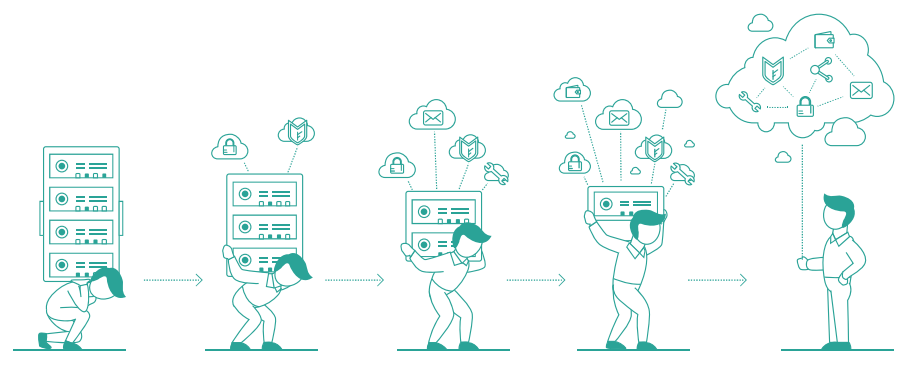Cloud Computing as technology is big in the job market right now. It is one of the desired domains to move into for most tech professionals. We all know how Cloud Computing helps store and manage data for personal and business use.
Experts say that by 2025, we will have generated around 163ZB of data – That’s more than one trillion gigabytes of data. With such volumes of data, we will need to store it in a place to be accessed via the Internet. The demand for Cloud Computing is exponentially rising year in and year out.
So, let’s take a look at how the concept of Cloud Computing came into existence and what the future holds for Cloud Computing.
Evolution of Cloud Computing
- 1960s: The Conceptual Era
- Birth of the idea of an “intergalactic computer network” by J.C.R. Licklider.
- Mainframe computers provided the first taste of shared computing resources.
- 1990s: Birth of the Modern Cloud
- Telecommunications switched from point-to-point data circuits to VPNs, hinting at the potential of cloud architecture.
- 2000s: The Growth Spurt
- 2002: AWS launched, offering a suite of cloud-based services.
- 2006: Amazon’s Elastic Compute Cloud (EC2) allowed individuals to run applications on their own virtual machines.
- 2010s: Mainstream Adoption
- Startups to Fortune 500 companies jumped on the cloud bandwagon.
- The rise of SaaS, PaaS, and IaaS models.
- Hybrid clouds, mixing private and public clouds, became a trend.
- 2020s: Sophistication & Integration
- Emphasis on edge computing, bringing computation closer to data sources (like IoT devices).
- Multi-cloud strategies, using multiple cloud providers, took off.
It all started in the ‘70s

To many, Cloud Computing is a term that recently came about. That is not entirely true. Let’s roll back a few decades. Back in the ‘70s, the concept of Virtual Machines was created.
Virtualization made it possible to use one or more operating systems in an isolated environment. The VM model took the Mainframe access model being used in the ‘50s to the next level. The fact that multiple distinct computing environments resided in one physical environment proved to be a game-changer.
Virtualized private connection of the ‘90s
Up until the 90s, telecom companies were offering point-to-point data connections. The newly offered virtual private connections offered the same reliability as their predecessor but at a reduced cost. Instead of building more hardware lines to provide connectivity to more users, telecom companies could now provide users with shared access to the same physical infrastructure.
Back in those days, we had Grid Computing, which solved large problems with parallel computing. We then moved on to Utility Computing, which offered resources as a metered service. SaaS or Software as a service, came in next. We then moved on to Cloud Computing, which offers anytime and anywhere access to IT resources delivered as a service.
The idea of an intergalactic computer network was introduced in the sixties by J.C.R Licklider, who was the brains behind ARPANET’s development in 1969. He envisioned an interconnected world where anyone could access a program or data from anywhere. This vision sounds a lot like what we call ‘Cloud Computing’ in today’s world.

Cloud Computing was only made possible in the 90s when the internet started offering substantial bandwidth. One of the first milestones of cloud computing was salesforce.com’s introduction in 1999, which delivered enterprise applications via a simple website.
The next development was Amazon Web Services in 2002. Jeff Bezos led Amazon to provide a suite of cloud-based services, including storage, computation, and even human intelligence through Amazon Mechanical Turk.
The Promising Present and Future
Around the year 2010, with internet speed and usage gaining stride, we saw the emergence of ‘killer apps’ from tech giants such as Microsoft and Google. When these companies deliver services in a reliable and easy way to consume, the knock-on effect on the industry as a whole is a wider general acceptance of online services.
The story does not finish here. The evolution of Cloud Computing is still on-going. With technological advancements, the Cloud space will only get bigger and better. It’s only natural to assume that Cloud-based services will grow equally exponentially. Many of these services are already extremely popular, and software, infrastructure, and platforms as a service will continue to be big shortly.
Cloud-based storage systems are also predicted to grow bigger and become a lot cheaper. Cisco predicts that global storage capacity will increase from 600EB to 1.1ZB in 2018, that’s almost twice the available storage of 2017.
Cloud is the backbone of IoT as well. Cloud Computing allows a range of devices to maintain connectivity and communicate with each other. With increased market use of IoT-based systems, cloud solutions will become more feasible and easily available for general uses.
With all that being said, it is apparent that cloud computing offers an array of solutions that our present world requires. Learning Cloud Computing can help you leverage these technological advancements and make a lasting career in this space.
Cloud computing future prospects is near us and will soon become a part of our reality.
The Future of Cloud Computing in 2023?
In our hyper-connected world, the rise of IoT platforms is a key driver for the future of cloud computing and its applications. As business applications migrate to public clouds and organizations increasingly use cloud-based deployment, the use of cloud computing is exploding.
Many companies are looking for open-source cloud computing services for their businesses because of lack of knowledge about how to manage cloud computing services.
As a cloud computing service provider, everyone has worked with various cloud service providers to help you better understand and implement the different types of cloud computing technologies in your business. We believe that companies will start building enterprise-centric cloud environments, but we are not surprised that companies are turning away from this.
With cloud waste, systems and platform management providers want to become part of the fast-growing cloud computing market, we understand that cloud management and operations are a key part of Computing, a new operating paradigm that requires new platforms and tools. The future of cloud computing can be seen as developing new cloud-based software products and services that will help create hybrid IT solutions.
Cloud computing is powerful, expansive and will continue to grow and offer many benefits in the future. Future cloud technology trends in cloud computing will continue to shape the way companies use public, private, and hybrid clouds.
The Future of Cloud Computing Security
Cloud security is a necessity that organizations prioritize, but it’s not just a trend this year in cloud computing. One of the key trends in cloud computing that will be seen in 2018 is the increasing security solutions that the cloud will bring. As IT 2022 is set to be a global pandemic, the cloud will and will remain a disruptive force in corporate IT.
The future of cloud computing depends heavily on users having secure systems to work within a technological environment.
DevSecOps is the best way to make the cloud unbreakable and take into account the cornerstones that can bend and break future cloud computing technologies. That is why cloud computing is ushering in a new era of security for the future, not just for corporate IT but for all technological working environments.
Enterprises can develop, deploy and manage their applications and software with server-less cloud computing much easier than ever before.
Cloud computing allows data to be stored online on remote servers or in smaller data blocks on several different machines worldwide, eliminating the need for companies to keep their servers on-site. In decentralized cloud computing, companies do not have to deal with a cloud provider who rents space in one place but divides the data they store in the cloud into small chunks that can be stored online or on a remote server.
A cloud database runs on any cloud computing platform and offers its users fully scalable access, providing high availability.
IoT cloud computing enables data to be stored and stored in a variety of ways and enhanced performance. IoT devices can use cloud computing because the cloud provides sufficient storage space to find resources, store data, and exchange information.
The role of containers and clusters in cloud computing will continue to grow as a new cloud – special apps are being developed, as containers are the fastest way to better applications. The container has been touted as the next metamorphosis of cloud computing, replacing the traditional hybrid cloud model of a single cloud with multiple private and public clouds.
Technology has grown significantly in recent years, with containers and clouds going hand in hand. They simplify deployment, management, and operational challenges often caused by hybrid clouds and are a faster way to deploy them better.
The blockchain movement will provide a huge opportunity for cloud computing in 2022. Blockchain, smart contracts, blockchain technology, and blockchain-as-a-service (BaaS) will combine to create a world of ubiquitous computing.
Conclusion
The trend towards cloud computing will continue to help companies in all industries benefit from cloud technology opportunities. Businesses across all industries benefit from the improved cloud performance, scalability, and cost-efficiency and the opportunities cloud technologies offer. The cloud-computing benefits such as cloud storage, analytics, and cloud services all help drive cloud technology.
This article shows how companies can use cloud-based solutions to gain a competitive advantage. I will try to answer some questions about how the cloud affects large companies, cloud computing, how organizations use it, and how it changes businesses.










Comments 10
Comments are closed.